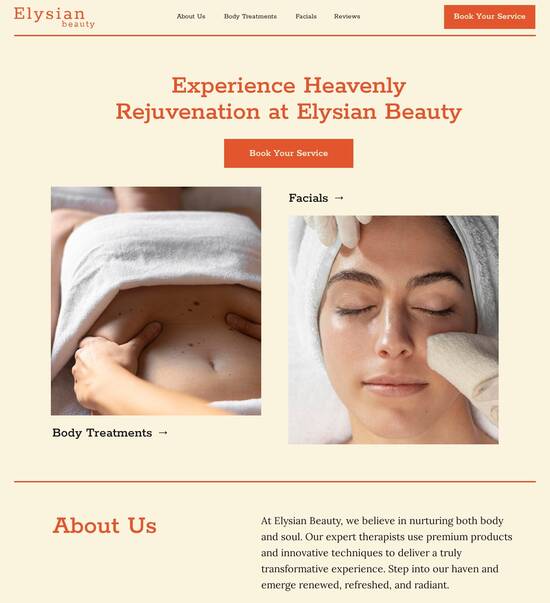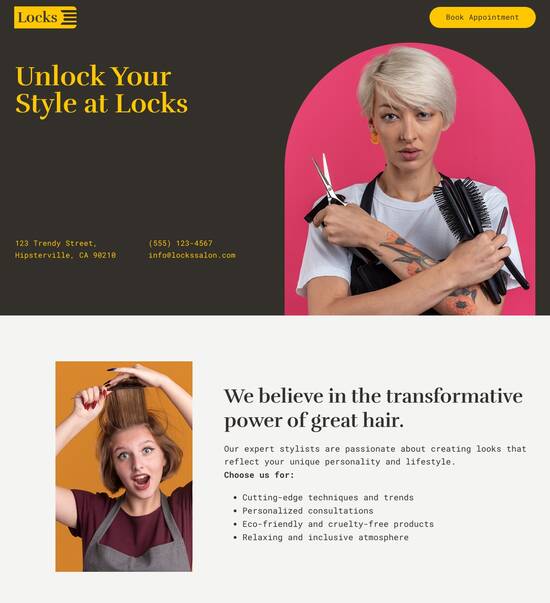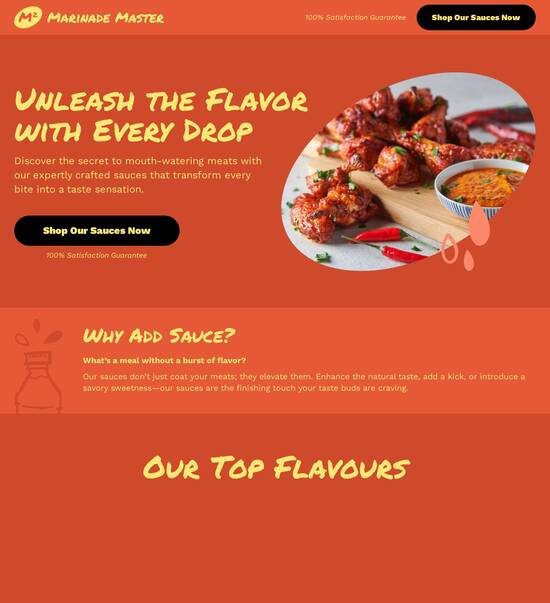
Next.js optimized event listing page template
Explore Similar TemplatesAbout template
Supercharge your event listing page with Next.js for outstanding performance! Learn more today.
Recommended templates

Easy to build without coding
With the intuitive drag-and-drop builder, anyone on your team can create high-converting pages without any knowledge of code or design. Make enhancements to your landing page with custom widgets using Javascript, HTML/CSS, or third-party scripts.

Multiple layouts for any industry and goal
Select from 500+ landing page layouts built to boost conversions across industry-specific scenarios. Customize them by adjusting fonts, adding images, and generating on-brand content with the AI assistant. Quickly scale with Instablocks® and Global Blocks that you can save, reuse, and update globally.

Loads fast and looks polished on any device
Every template is responsive, which means they present professionally on any device and load blazingly fast with our Thor Render Engine. You can also power them up with Google AMP technology to deliver an unparalleled mobile experience and drive higher conversions.

Robust analytics & experimentation
Get real-time updates and reporting across all your devices, showing the number of visitors, conversions, cost-per-visitor, and cost-per-lead. Launch AI-powered experiments, run A/B tests, and use heatmaps to analyze user behavior, then optimize your landing page to maximize conversions.







Easy to build without coding
With the intuitive drag-and-drop builder, anyone on your team can create high-converting pages without any knowledge of code or design. Make enhancements to your landing page with custom widgets using Javascript, HTML/CSS, or third-party scripts.
Multiple layouts for any industry and goal
Select from 500+ landing page layouts built to boost conversions across industry-specific scenarios. Customize them by adjusting fonts, adding images, and generating on-brand content with the AI assistant. Quickly scale with Instablocks® and Global Blocks that you can save, reuse, and update globally.
Loads fast and looks polished on any device
Every template is responsive, which means they present professionally on any device and load blazingly fast with our Thor Render Engine.
Robust analytics & experimentation
Get real-time updates and reporting across all your devices, showing the number of visitors, conversions, cost-per-visitor, and cost-per-lead. Launch AI-powered experiments, run A/B tests, and use heatmaps to analyze user behavior, then optimize your landing page to maximize conversions.
All the features you need to build lead-generating landing pages
Explore more featuresLearn how to build top-performing landing pages for any goal
FAQs
Leading the way in building high-performing landing pages





Unlocking the power of Instapage for high-conversion landing pages
Creating effective landing pages is crucial for driving conversions in digital marketing campaigns. Instapage stands out as a comprehensive platform designed to accelerate and optimize your marketing efforts. With its user-friendly features, marketers can easily scale campaigns and maximize ROI, regardless of budget or team size.
Understanding the essentials of Instapage
Instapage provides marketers with an all-in-one solution for landing page creation and conversion rate optimization (CRO). With over 100 customizable templates and intuitive builders, you can rapidly launch high-performing landing pages tailored to your audience. This platform eliminates the need for coding skills, making it accessible for teams of all sizes.
- Diverse templates: Choose from a wide array of high-converting templates that cater to various industries and target audiences.
- Built-in lead generation: Instapage includes essential elements like forms and call-to-action buttons to help capture leads right from the get-go.
- Real-time collaboration: Work seamlessly with your team, providing feedback and edits directly on your landing pages, enhancing the production process.
Step 1: Crafting your landing page
The first step involves using Instapage’s flexible page creation tools to build your landing page. Think about your target audience and select a template that resonates with their needs. Customize the content, images, and forms to ensure a personalized experience.
Step 2: Optimize for conversions
Once your page is built, it’s essential to optimize it for better conversions. Utilize A/B testing to compare different versions of your page, and apply heatmaps to understand user behavior.
- A/B testing: Experiment with different headlines and calls to action to discover what resonates best with your audience.
- Heatmaps: Analyze where users click most on your pages to adjust layouts for better visibility and engagement.
- Analytics dashboard: Track performance metrics in real-time to continuously refine your campaigns based on data-driven insights.
Step 3: Personalize the user experience
Promoting a tailored experience is key to increasing engagement. Utilize Instapage's personalization features like dynamic text replacement and audience segmentation to deliver targeted messages to specific groups.
- Dynamic text replacement: Automatically change text on your landing pages based on the visitor's source or ad campaign.
- AdMaps integration: Align targeted ads with specific landing pages for a coherent user journey.
- Audience-level tracking: Measure effectiveness by tracking how different segments respond to your campaigns.
By effectively utilizing Instapage's features, you can create landing pages that not only attract visitors but also convert them into leads and customers.
Start transforming your marketing campaigns today with Instapage. Sign up for a free trial now and see how these powerful features can elevate your campaigns to the next level.
Next.js optimized event listing page template
The foundation of Next.js: An overview of its optimized event listing page capabilities
Next.js has emerged as a go-to framework for building optimized web applications, especially for event listing pages. Understanding how it operates allows developers to harness its full potential. Utilizing both static site generation (SSG) and server-side rendering (SSR), Next.js ensures that content is delivered swiftly while optimizing SEO. This makes Next.js particularly valuable for event listings, where timely data visibility and performance are crucial to user engagement.
By leveraging SSR, Next.js pre-renders pages on the server, delivering a fully constructed page to the user, which speeds up load times and improves the overall user experience. On the other hand, SSG generates HTML pages at build time, making it suitable for static or less frequently updated event data. Choosing the appropriate rendering method can greatly enhance the performance and accessibility of your event listing page.
Designing a robust event listing template
When creating an event listing template, several core attributes are essential for maximizing effectiveness. First and foremost, flexibility is key; the template must adapt to various event types ranging from conferences to casual meetups. Developers should define a structure that allows easy customization, facilitating the quick application of changes for different events. Another critical attribute is scalability; as user data and events increase, templates should handle this growth without compromising performance.
Responsiveness plays a vital role as well, ensuring that users have an optimized experience on desktops, tablets, and smartphones. With a significant portion of web traffic coming from mobile devices, a responsive design facilitates easy navigation and enhances user satisfaction. Adopting a mobile-first approach during the design phase can save time and resources in later optimization stages.
Flexibility: Adapts as per event requirements.
Scalability: Handles increasing data smoothly.
Responsiveness: Provides a great experience on all devices.
Additionally, essential components such as a well-defined header section, featuring branding and intuitive navigation, set the tone for user interactions. Event cards should be visually appealing and include critical details, such as date and time, location, and ticket information. This information needs to be displayed clearly for users to make informed decisions and engage with events effortlessly.
Leveraging user data for personalization
To enhance user experience on an event listing page, collecting user data efficiently is paramount. This can be achieved through registration forms where users willingly provide information as they sign up for events. Additionally, engagement tracking tools allow insight into user interactions, enabling templates to adapt based on how visitors navigate the site. It's vital to implement robust security measures to protect this data, ensuring users feel safe sharing their information.
With effective data collection processes in place, the next step involves utilizing this information for dynamic listings. Personalization techniques can include customized greetings, recommended events based on past activities, or even tailored offers based on user preferences. This level of personalization not only improves user experience but can also significantly boost engagement and conversion rates.
Advanced features of the event listing page
Integrating interactive maps into the event listing page provides essential geographical context for potential attendees. A properly implemented map can assist users in locating venues easily, providing directional features for convenience. UI design considerations for maps should ensure that users can zoom in or out and pin locations to enhance interactivity. Features such as satellite view and street view can add depth to the experience, allowing users to familiarize themselves with the area.
Moreover, fostering collaboration among event teams is crucial for the efficient management of listings. Introducing features that enable teams to coordinate tasks, share updates, and manage feedback can streamline the entire process. Engaging users through feedback features can also create a robust community around events, fostering dialogue and questions that enhance shared experiences.
Navigating the route to event discovery
Creating an intuitive navigation experience is essential for users seeking events. Structuring routes effectively allows for easy access to event listings and details, which enhances user satisfaction. Including breadcrumbs in the navigation aids in user orientation, ensuring they can track their path back to previous pages without confusion. Clear labeling improves usability by directing users efficiently through the site.
In addition, incorporating filters and tags can significantly enhance event discoverability. Implementing advanced search capabilities enables users to refine searches based on specific criteria like genre, location, or date. Tags further improve this feature, allowing users to quickly find events that match their interests, thus boosting engagement and attendance rates.
Utilizing technologies to enhance the template
The integration of APIs and third-party services opens up a plethora of opportunities for real-time data on event listing pages. For instance, enabling ticketing and registration through APIs can streamline the entire user experience, allowing for quick sign-ups and instant access to event details. Many companies have successfully implemented such systems, resulting in improved customer engagement and satisfaction.
Performance optimization technologies, including static generation and incremental static regeneration, further enhance the effectiveness of event listings. These techniques ensure users experience fast load times, which is critical in retaining visitors. Additionally, utilizing caching strategies can further optimize load performance, ensuring users of all backgrounds have a seamless browsing experience.
Engaging with content strategically
Content strategy plays an integral role in event promotion on listing pages. Rich, engaging visuals combined with detailed descriptions create a compelling narrative for each event. Regularly updating the content allows for ongoing engagement and keeps information relevant. Additionally, blogs and articles related to events can direct traffic, further enhancing user engagement on listing pages.
Previewing event content effectively is crucial for capturing interest. Designers should focus on crafting alluring event previews that communicate essential information at a glance. Utilizing multimedia elements, such as videos and photo galleries, can further enhance previews, creating a more immersive experience that entices potential attendees.
Creating a collective memory: Cultivating communities around events
Building platforms for community discussions enhances user engagement around events, allowing attendees to share experiences and feedback. Comment sections and forums can facilitate these discussions, encouraging users to not only participate actively but also contribute to the collective memory of the events. This social interaction creates a vibrant community that fosters loyalty and engagement.
Sophisticated loyalty programs can encourage repeat attendance. Designing rewards for loyal attendees can create a sense of belonging and community. Furthermore, subtly integrating feedback loops into the experience allows organizers to continuously enhance the event based on attendee input, thus building trust and improving future participation.
Ensuring maintenance and updates of the template
Ongoing maintenance is crucial for an optimized event listing page template. Implementing best practices for template file management can simplify the process of incorporating updates. Utilizing version control systems enables teams to track changes quickly and retrieve older versions if needed, ensuring that all improvements contribute positively to user experience.
Moreover, continuously gathering feedback to assess the template effectiveness is vital. Engaging users in this process can provide valuable insights, guiding developers towards enhancements that genuinely resonate with their audience. Monitoring key metrics is also necessary – these data points help in reinforcing areas of strength while illuminating opportunities for improvement.
Real-world use cases and success stories
Examining successful implementations of Next.js event listings can provide invaluable insights. Numerous companies have enhanced their user engagement strategy using tailored templates. For example, a leading tech company's event page redesign led to a significant increase in ticket sales due to its intuitive navigation and compelling content presentation.
From these case studies, aspiring developers can learn scalable strategies that include focusing on mobile responsiveness, simplifying the user journey, and leveraging API integrations for real-time functionalities. Analyzing such successes will pave the way for future innovations in the event listing domain.
Future trends in event listing pages
As user behaviors and expectations evolve, staying ahead of future trends in event listing optimization is essential. Predictions suggest that increased personalization and interactivity will shape the landscape, with technologies like AI and machine learning driving these changes. Such advancements aim to create hyper-personalized experiences for users, which can determine event success.
In addition, the integration of advanced data analytics will allow event organizers to grasp deeper insights into user behaviors and preferences. These tools will aid in tailoring future events and marketing strategies, ensuring that offerings align closely with user needs and expectations.
Innovative takes on event listings: Beyond the template
Exploring novel concepts for event listings can have profound implications for user engagement. Immersive experiences that bridge the digital and physical realms can elevate traditional event promotion to new heights. Integrating augmented reality features into event listings allows users to preview an immersive experience before attending, creating anticipation and excitement.
These innovative strategies could set the stage for future events, enhancing attendee interaction from the initial point of discovery. By creatively integrating emerging technologies, event marketers can redefine how users perceive and participate in events, cultivating unforgettable experiences that resonate with their target audiences.
Ready to skyrocket conversions?
Supercharge your ad campaigns with high-performing landing pages
Get started














